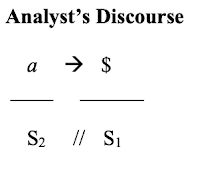Discourses that heal, discourses that harm
Imagine an inner city riding school for children who live in high rise council estates or attend the local special needs school. I don't think many would say anything other than, “Wow, what a great idea!” Horses appearing in urban environments seem to have a transforming effect on humans. Not all humans, but many stop to smile and say hello when they see the horses out on the road and this introduces a real change in the experience of living in the city. The real presence of this large animal in a modern urban area can interrupt the discursive machinery that organises the city's daily life. It can be capable of moving the machinery into a different discourse which often releases a little bit of love.
In Paris, 1968, Lacan famously said that there are structures marching in the street. He was talking about structures of discourse. These structures of discourse are not as visible as horses and can only be deduced by their effects. They leave traces which can be read from their consequences. These structures are capable of transforming a lot of real things, including humans and horses, in hidden and unexpected ways. For example, when Lacan addressed the students who were protesting in the streets of Paris, he was pointing to the structure of their speech. Words full of passion, hurled at the supposed master in order to reveal his lack and undermine his power, are words organised by the hysteric's discourse. There are problems with this discourse: it requires the subject to suffer a bit too much, and sometimes the damaged master is replaced by a much stronger one, worse in so many ways. The hysteric's discourse can be an infernal machine of perpetual suffering.
Machinery of speech – structures of discourse – can neither be seen, nor held in the hand nor measured with physical instruments, so, for the most part, humans tend to carry on as if they don't exist. Psychoanalysis in the Lacanian orientation does not have this luxury. Practicing in this tradition behoves the practitioner to acquire a know-how in operating the Analyst's Discourse. This is Freud's true invention, but it took Lacan to say it. The Analyst's Discourse is on the backside of the Master's Discourse and can be written by rotating the Master's Discourse through two out of the four turns of the grid. This discourse is even more important than the body of knowledge that is acquired and collected together in books and journals. Like those who master the art of horse riding, psychoanalysis is only proved in action.
In our inner-city stable yard, there live about ten horses who are loved by all and well looked after by a lot of splendid people. But everyone participates in and reproduces the discursive structures that make up daily life. There is the stuff of routine, the ticking of the clock, the ticking of the check-boxes, the production of statistics, the measurement of expenses, the rotation of staff, the routine of volunteers, the evaluation of appropriate behaviour, the DBS surveillance, the tradition of British riding lessons, the examinations and inspections, and the particular meter of the management style that tries to set the scene. In short, there are a lot of little and not so little discursive routines and practices operating all over the place, many operating so unconsciously as to be operating automatically.
First of all the signs appeared in two of the oldest members of the herd, both of whom have been seen as mentors and leaders for the other horses. Some of the longest serving volunteers and more regular staff begin to notice that theses two big steady horses seem to be “dead behind the eyes.” After a long and careful process good homes will be found and tearful goodbyes will be said. When all the horses will go off for their Christmas break, these two will not return. A few weeks later as January stiffens to February, staff and volunteers will be dismayed to read a memo that is unexpectedly circulated. Two of the other horses are now showing signs of distress. One of them is revealing himself to be in so much pain that the difficult decision will have to be taken to put him to sleep. “Don't tell the children yet,” the memo implores.
That's four horses out of ten.
Could it be that the structures of human discourse are capable of killing a pony?
The manager at our inner city stable yard, glancing out of her office window, once witnessed a situation she really didn't like. She saw a child “having a meltdown” in the middle of the yard. Her eyebrows arched as she observed her staff and volunteers “just standing around” waiting for the child to calm down. “It is unacceptable,” she said to herself. The only proper response is to control and restrain the child. She knew this from her previous role. Bring it under control! Quickly! Physically! Decisively! The very next week, when a child from the special needs school took a bit longer than the others to fall into line, he is grabbed by the arm, pushed and pulled, and shoved and shouted at until he begins to show signs that the words are having an effect.
Jacques Lacan, “Proposition of 9 October 1967 on the Psychoanalyst of the School,” Analysis 6 (1995) 1-33.
Jacques Lacan, Seminar XXVII, The Other Side of Psychoanalysis [1969-1970], text established by Jacques-Alain Miller, trans. R. Grigg, New York/London Norton, 2007.







Comments
Post a Comment